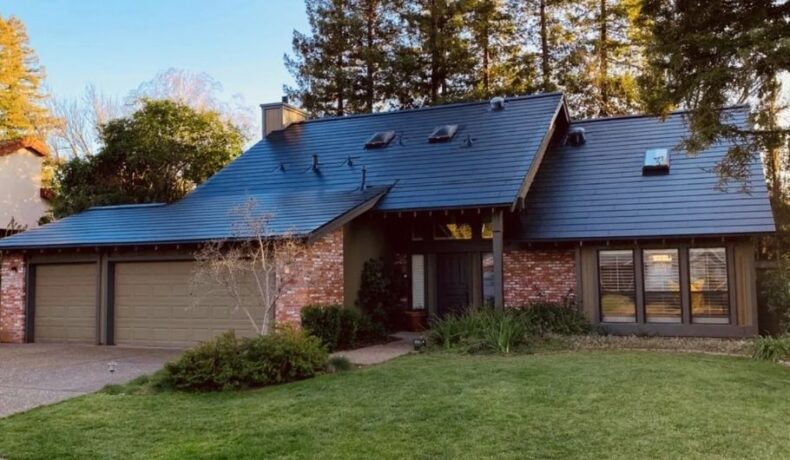The Tesla solar roof is another brand-new product that offers large scale energy savings compared to a typical modern rooftop.
Elon Musk unveiled this latest addition to the Tesla offerings back on October 28, 2016, along with the announcement that Tesla will be acquiring SolarCity.
According to Elon Musk, Tesla’s goal is to make solar roofs:
- Look better than a normal roof
- Generate electricity
- Durable and last longer
- Have better insulation, and
- Have an installed cost that is less than a normal roof plus the cost of electricity.
Therefore, Tesla solar roofs are better for people who want to earn money off their rooftops. It proposes making your roof an investment asset rather than simply a liability.
So, does this value proposition make sense, or should you avoid it?
Tesla solar roofs are a good pick over traditional rooftops. It is perfect for people who have an upcoming canopy overhaul and want to add value to their property and electricity savings. However, for the pure rational investor, solar panels are still by far the quickest way to get a return on your investments.
Table of Contents
What is a Tesla Solar Roof?
The Tesla solar roof is the latest innovation from Tesla, which allows your rooftop to generate solar energy and earn you savings.
It is the same as a solar panel but blends in as a typical granite-looking rooftop which is the highlight of this Tesla product.
Each tile comes with a lifetime of the house warranty and 30-year power generation guaranteed. After the electricity production, Tesla estimates that its solar roof will be cheaper than regular tile roofs or virtually pay for itself through electricity savings.
Now let’s talk about choices. In general, each solar roof tile comes with a “color louver film” covering. The unique film allows the Tesla solar roof tiles to blend into the roof while exposing them to the sun above. Lastly, each tile has tempered glass on top for durability. Talk about icing on the cake.
As of the moment, Tesla Solar Roofs come in four flavors: Textured Glass Tile, Slate Glass Tile, Tuscan Glass Tile, and Smooth Glass Tile.


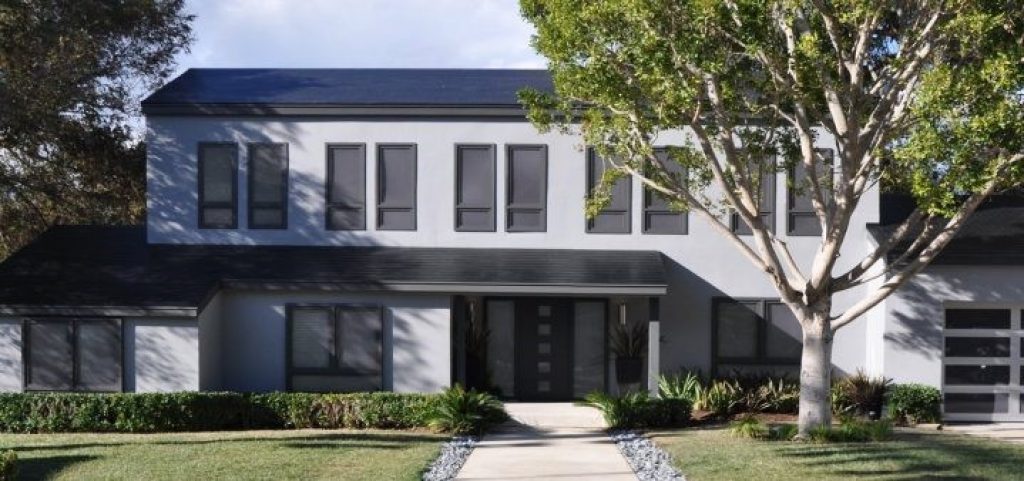

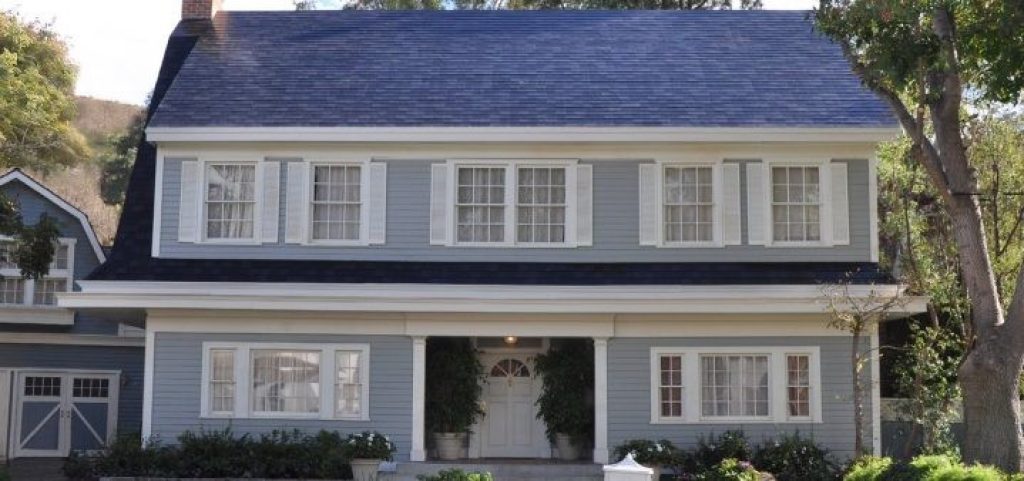
How Does A Tesla Solar Roof Work?
So how does a Tesla Solar Roof Work exactly? Simply put, through its solar energy business companies, SolarCity and Tesla Energy, Tesla introduced a natural-looking solar panel variation. It works precisely like a solar panel, using high-efficiency solar cells and modules integrated inside textured solar roof tiles.
They are meant to compete more with traditional roofs that need replacement than their solar panel cousins. However, one cannot avoid comparing whether you are an enthusiastic clean energy supporter or a rational investor.
How Much Does A Tesla Solar Roof Cost?
According to Tesla itself, a typical homeowner can expect a rate of $21.85 per square foot when they decide to replace their existing tiles with Tesla Solar Roofs.
The latest solar tile model (version 3) is 114 cm long by 43 cm wide and is rated at 58 watts. Each tile costs about $6.49 per watt.
Many factors play into the pricing so expect some variations. Still, electricity bills, system size, roof complexity, and location have the most significant impact overall. You can play with these dials yourself using Tesla’s website.
We want to point out that this online calculator often recommends add-ons such as a Tesla Power wall. It’s not bad, but we still want to inform you about this feature.
Is A Tesla Solar Roof A Good Investment?

Okay, before we proceed, we want to point out that the following two (2) sections are the core discussions for this post. They are lengthy and may require some patience to grasp fully. However, if you hang in there, these will help you understand how to compare alternatives when deciding what to do with your roof investment.
In summary, we will compare:
- Different solar roof investment alternatives;
- How to decide which one to go with; and
- Whether you should get add-on energy storage and solar roof tiles so you can power your entire house on solar energy alone.
All good? Great, let’s proceed.
Analyzing Project Alternatives
Now, for you money-conscious investors out there, let’s discuss if a Tesla Solar Roof is a good investment. To answer this question, we will compare four alternatives:
- Solar Panel
- Solar Roof
- Solar Panel plus roof replacement
- Roof Replacement only
For this simple case study, we will consider a 1000 sqft, single-story home in California that has an average monthly bill of $150
| Scenarios / Project Alternatives | Typical Roofing Replacement Cost | Solar System Size | Tesla Solar Panel Cost | Total Cost (with Solar Tax Credits) | Payback Period |
| Solar Panel Only | None | 9.6 kW | $14,278 | $14,278 | 9 years |
| Solar Roof | Included | 10.83 kW | $36,000 | $36,000 | 20 years |
| Solar Panel with Roof Replacement | $5,100 to $11,000 | 9.6 kW | $14,278 | $19,378 to $25,278 | 12-16 years |
| Roof Replacement Only | $5,100 to $11,000 | None | None | $5,100 to $11,000 | None |
Tesla Solar Panel and No Roof Replacement
For this project alternative, Tesla recommended a 9.6kW solar panel system. The project is estimated to cost you $19,294. Applying the current Solar Tax Credit will bring down the cost to $14,278.
According to the Tesla Online Calculator, a $150 monthly bill in California translates to $1,800 and 15,185 kWh of electricity consumption per year. A 9.6 kW system will offset 89% of your annual energy consumption, earning you $1,602 of electricity savings each year.
However, we recommend purchasing an energy storage device if most of your electricity consumption is done before and after daylight.
Computing the payback period is done by dividing the total solar system cost by the annual electricity savings. Hence, dividing $14,278 by $1,602 will give you an expected payback period of about nine years (8.9126 years).
If you are curious to know more about payback periods, we recommend browsing this previous article we made.
Tesla Solar Roof Investment
For the following alternative on the same house setting, Tesla recommends a 10.83 kW solar roof system. The project is estimated to cost you $48,700. Applying the current Solar Tax Credit will bring down the cost to $36,000.
This system is enough to cover your entire 15,185 kWh consumption for the whole year, with a total annual savings of $1,800.
Using the same payback period methodology, expect to wait twenty years to get the money spent on your Tesla Solar Roof + roof replacement.
Tesla Solar Panel with Roof Replacement
If you consider this alternative, it might mean that your roof needs to be replaced sooner or later. You want to know if going with solar panels will give you a quicker ROI than the Tesla Solar Roof option.
Based on what we found out there, the cost of roof replacement service varies for plenty of reasons. On average, expect to pay between $5,100 to $11,000. We can now use this information to update the ROI period of our first alternative.
In our study, the Tesla Solar Panel system alone already cost $14,278. Adding roof replacement costs will yield you $19,378 to $25,278. This translates to a payback period ranging between 12 to 16 years.
Roof Replacement Only
It is unlikely that a reader of a Climatebiz article would be interested in taking this route. Still, it is always good to consider “base cases” to appreciate the entire cost-benefit analysis process.
With that being said, choosing to solely replace your roof without either solar panels or solar roof tiles will cost you $5,000 to $11,000. This means you will shell out this amount with zero chance of getting your money back (see the figure below). However, this is a relatively small price to pay compared to going solar.
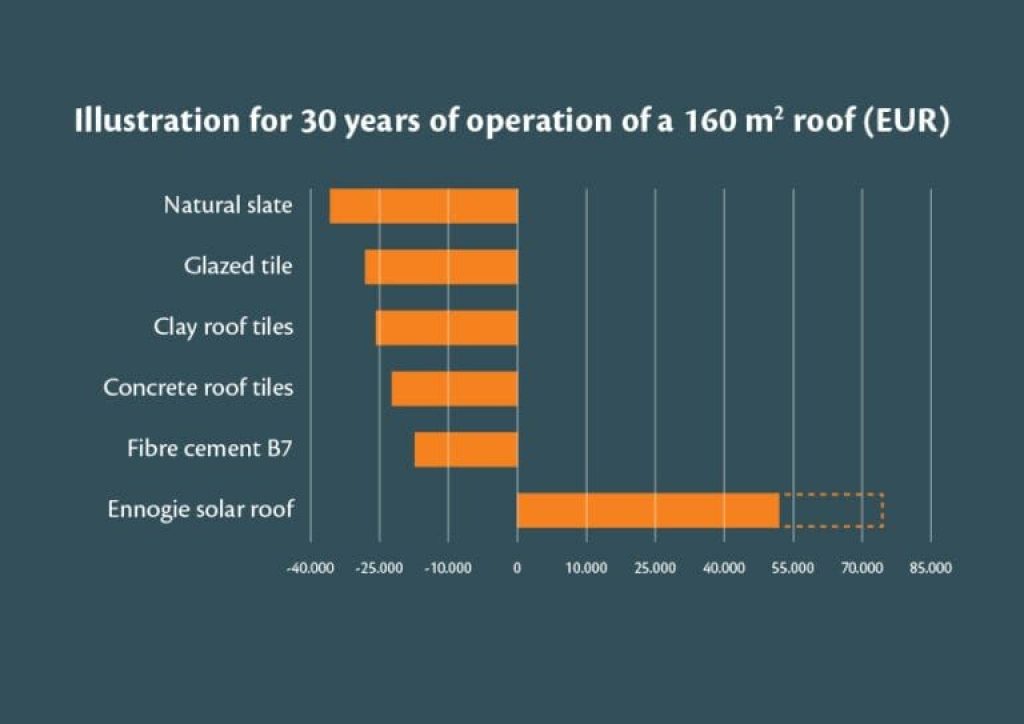
Thinking about it more rationally from a purely financial standpoint. You can also choose to invest the savings from deciding not to go solar, yielding compounded interest.
Can A Tesla Solar Roof Power My Entire House?
“Can A Tesla Solar Roof Power My Entire House?”
Now, this could be a tricky question for some of you.
Yes, in a way, a Tesla Solar Roof system can power an entire house. Now, we can go two ways from here:
- We can be content with this straightforward answer and move on to the next section; or
- We can ask an additional question and wonder how long can a tesla solar roof power my entire house.
For the latter, it depends on how much power and energy your Tesla Solar Roof produces. Therefore, it is good to know the difference between the two.
Simply put, power is the WORK done by an electric circuit. In this case, the electric circuit is your Tesla Solar Roof tiles that are wired to a power inverter. On the other hand, energy tells us HOW LONG can an electric circuit produce power. This is why power units are expressed in WATTS while energy is expressed in WATT-HOURS.
Factor Affecting Tesla Solar Roof Energy Production
Next, recall that solar power and energy production depends on many things.
Suppose you are not yet familiar with this concept and would like to know more. In that case, we recommend quickly going through previous articles we made covering this topic. We promise it is worth your time if you are interested in geeking out on irradiation, roof tilt, solar panel orientation, and duck curves.
But, in a way, a properly-sized Tesla Solar Roof can roughly power an entire house for about four hours on a sunny day. If you want to run your home on primarily solar energy, you could do it by doing two things:
First, getting an energy storage system. In the case of Tesla, they have what you call a power wall that can be integrated with the solar roof and store solar energy for later use.
Peak Sun Hours
Second, you could get more solar power depending on your electricity consumption. The reason why is because, ideally, on a good day, your solar roof receives an equivalent of about 5 hours of direct sunlight daily. These are also called peak sun hours, and they vary depending on your location (see figure below). You can find out your number through our online resource.
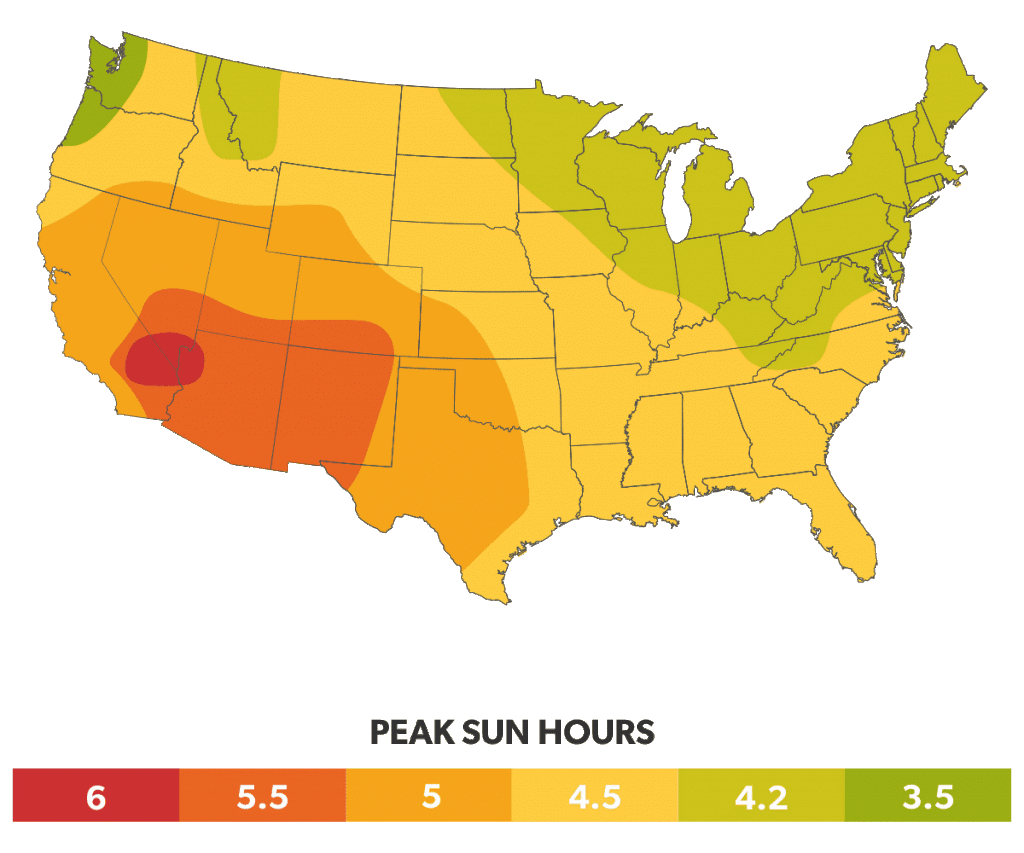
Your solar roof produces power that looks like the graph on the bottom left-hand side during a good day. However, days aren’t always ideal, as you can see on the bottom-right-hand side.
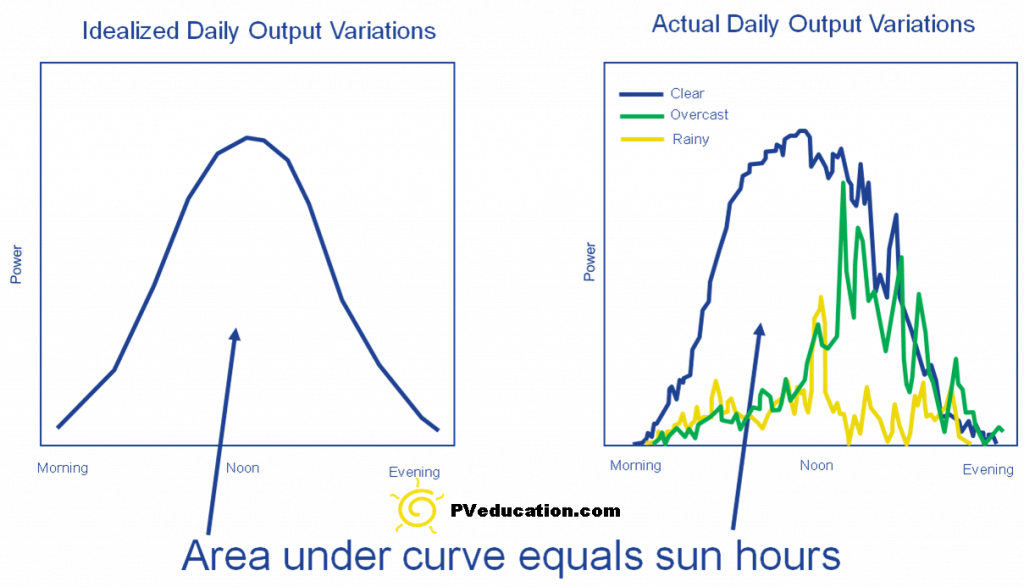
This means that even though your solar roof is receiving irradiance in the wee hours of the morning, it is not receiving enough to produce maximum power. In effect, your solar roof makes energy equivalent to 5 hours of its full power daily.
Energy Storage to Maximize Solar Energy Use
Therefore, having add-ons like (1) additional solar roof tiles and (2) an energy storage device allows you to:
- Fully offset your electricity consumption;
- Store solar energy; and
- Utilize it more efficiently (time of use)
A Tesla Power Wall that can store a day’s worth of energy in our sample household costs $10,500. Upgrading it to hold two or three days of energy storage capacity will cost you $17,000 and $23,500, respectively.
This add-on is perfect if most of your electricity consumption is during early mornings and evenings without sunlight.
Now, this is just the tip of the iceberg. Energy storage is a rabbit hole on its own, and we geeked out on this topic a while back. Suppose you are interested in an additional discussion about Tesla Power Wall energy storage devices. In that case, we recommend reading this section of our article.
How Long Does A Tesla Solar Roof Take To Install?
According to Tesla, How long it takes to install a solar roof depends on the solar system size and complexity of the roof, as shown in the figure below. It also depends on how quickly the utility permits you to operate a Tesla Solar Roof after the testing and commissioning phase.
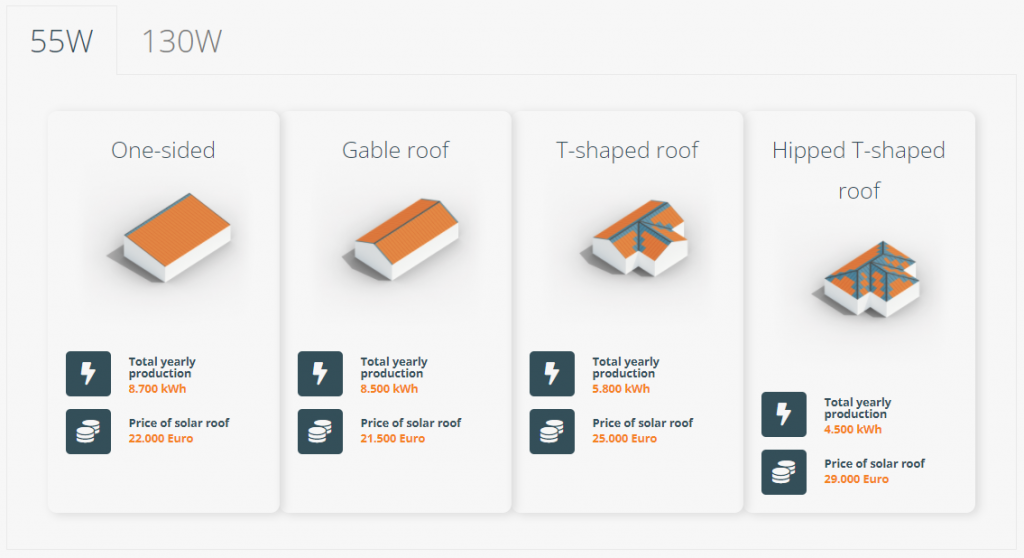
Don’t worry, though. Tesla includes handling the permitting process in the installation package.
Does A Tesla Solar Roof Increase The Value Of My Home?
Now, does install a Tesla Solar Roof increase the value of your home? Yes, but make sure to advertise it properly since you will be putting an additional financial burden on the next homeowner.
Here’s a sales tip: advertising the low electricity bill that comes with buying the home with supporting documents such as the previous year’s total bill. You can then compare this to years when the house didn’t have a Tesla Solar Roof yet.
However, please ensure that you have fully paid for the solar roof to avoid complications post-purchase.
In summary, having a Tesla Solar Roof will increase the value of your home. It can be a good selling point for your house through low electricity bills and are perfect for clean energy supporters. However, make sure you have settled your loan obligations before selling the home to avoid problems.
Will A Tesla Solar Roof Catch On Fire?
Whether solar panels or solar roof tiles, photovoltaic systems have a low risk of catching fire. A study was done back in 2018 that backs this up. Fire emergency risks in PV systems are negligible as long as fire protection standards, high-quality components, and proper installation practices.
The most considerable risk of a solar rooftop posing a fire hazard is the lack of regular inspections and maintenance after special events such as storms or earthquakes. But in general, PV systems pose no particular concern for fire dangers.
And yet, despite these facts, a recent incident involving Tesla and solar fires made it to news headlines wherein Tesla solar panels caught fire at an Amazon and Walmart facility. Allegations were focused on poor installation practice, according to former Tesla employees.
Climatebiz still maintains that solar fires shouldn’t cause excessive worry despite these current events. Besides, solar roof installations are inspected by local fire departments before their owner receives the Permission to Operate (PTO), which is considered the utility’s seal of approval that the Tesla Solar Roof is safe and works as intended.
Does A Tesla Solar Roof Make Noise?
Tesla Solar Roofs do not make any noise once installed. These tiles are connected to inverters that operate at a low decibel output, so you can expect no annoying buzzing sounds or motor noises like the ones standby generators make.
In conclusion, you can expect no problems from Tesla Solar Roofs in the noise department.
Is A Tesla Solar Roof Waterproof?
Yes, aside from durability, Tesla Solar Roofs are also waterproof and can fully protect your home during storms and other potential water calamities. When your solar installer finishes putting up your solar roof, you can observe that these solar tiles overlap to prevent leaks.
For more complex roofing architectures, your installer should have a solution ready to keep sure that the Tesla Solar Roof behaves like a typical roof and keeps all the water out of harm’s way.
Tesla offers a comprehensive 25-year warranty covering materials, installation, labor, parts, and electrical components. This means that if anything goes wrong, repairs and replacements are covered by Tesla.
Final Thoughts
Tesla solar roofs are an innovation from Elon Musk’s team that promises to deliver solar energy with a more visual appeal compared to other more common solar panels. They are perfect for clean energy supporters who want to do their share in the green movement while keeping their rooftops’ slick and low-key look.
However, in our cost-benefit analysis, we saw that you could get your money back twice as fast if you stuck with a normal solar panel system.
Don’t get us wrong. We love the designs and flavours a Tesla Solar Roof has to offer. However, surely Elon could be even more generous by allowing for a price drop similar to what solar panels experienced in the past decade.
Addressing the Elephant in the Room about Tesla
Some controversies are surrounding Tesla recently regarding safety and their sincere commitment to delivering on their promise. Solar fires have been a buzzword in the past few years, but they shouldn’t cause any excess worry since studies prove that PV systems have a negligible risk of catching fire.
Now, Suppose you can’t shake off feeling anxious about these things. In that case, we recommend talking to your solar installer about frequent preventive maintenance focusing on fire hazards such as arc flash, and choosing the best underlayment material suitable to your needs.
For those unfamiliar with what we said, arc flash is a phenomenon where electricity produces a light and heat arc discharge due to exposed electrical wiring coming in close contact with its surroundings. Proper installation practices and regular maintenance can remedy this.
On the other hand, an underlayment is a barrier that goes between the roof’s deck and the top layers, may they be shingles or tiles. It serves as a barrier protecting your home from the entire spectrum of elemental risks such as water, moisture, chemical, and thermal build-up.
Ask your installer which type of underlayment is best for fire prevention in your case.
Teaching our Savvy Readers How to Fish
Now, if you withstood the cost-comparison analysis earlier like a champ, we want to say congratulations. You are the real MVP, and it just shows that you take this major decision as seriously as they come.
We understand that the considerations for the tesla solar roof case study are limited. However, your key takeaway from today’s analysis is learning the ropes on comparing alternatives and weighing options.
Here at Climatebiz, we also subscribe to the concept of teaching people how to fish. Now suppose if you have varying situations from the analysis we presented. Then, you can simply plug in your personal information over at the Tesla Solar Roof online calculator and do customized cost-benefit research.
WWhat’simportant is that we have now demonstrated that solar panels are the best from a purely investment-driven perspective. Tesla Solar Roofs are worth considering if you are looking to replace your rooftops since it earns you back your money spent in the long run compared to a simple roof replacement.
Going beyond the Payback Period
Arguably, investing your money saved from the “Roof Replacement Only” scenario into something else like the stock market might be enticing financially as well. However, the beauty of going solar is that your decisions are likely to evolve from a profit-only bottom line into what we call a triple bottom line which considers economic, environmental, and societal profits.
Whether you choose solar panels or Tesla solar roof tiles, going solar in itself is already a worthwhile endeavor. It has a lot of wins in the intangible benefits category.

